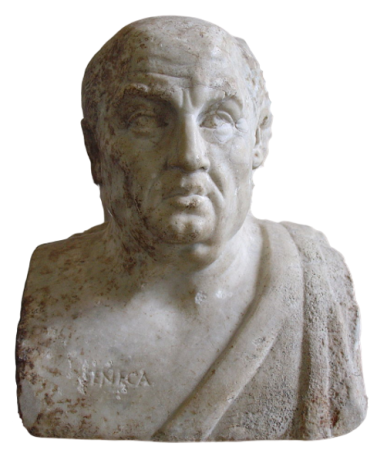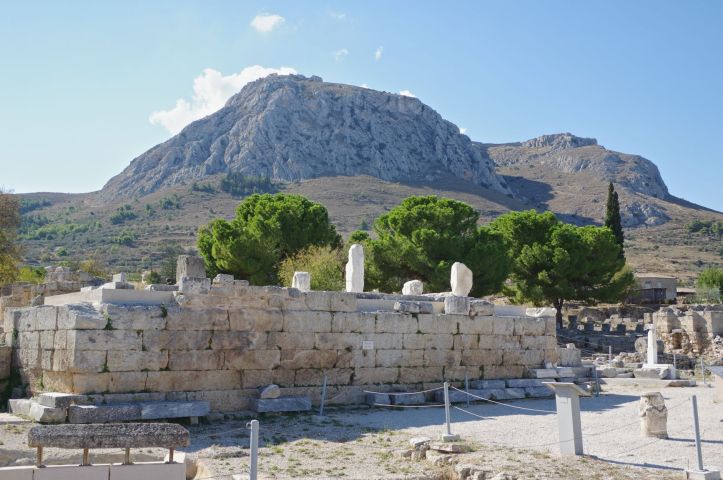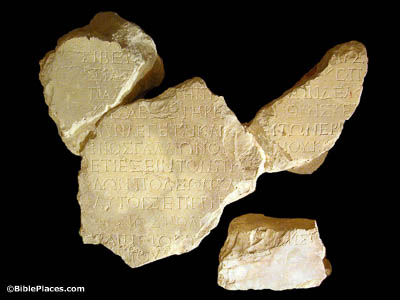
Lucius Annaeus Novatus was born ca. 5 BC in Corduba (modern-day Córdoba, Spain). His father was Seneca the Elder and his brother was the philosopher, Seneca the Younger, who became the tutor of the future Emperor Nero. Upon his adoption by the Roman senator, Junius Gallio, he changed his name to Lucius Junius Gallio Annaeanus.1 In AD 51, he was chosen to serve as the proconsul of Achaea in Greece. It was in this role that the Apostle Paul met him in Corinth when the Jews brought charges against him.
In Acts 18:12-16 we read:
“But when Gallio was proconsul of Achaia, the Jews made a united attack on Paul and brought him before the tribunal, saying, “This man is persuading people to worship God contrary to the law.”
But when Paul was about to open his mouth, Gallio said to the Jews, “If it were a matter of wrongdoing or vicious crime, O Jews, I would have reason to accept your complaint. But since it is a matter of questions about words and names and your own law, see to it yourselves. I refuse to be a judge of these things.”
And he drove them from the tribunal.”
Extra-Biblical Sources

Our knowledge of Gallio comes not only from Scripture, but also from other writers outside of the Bible. Gallio’s brother, Seneca, described him as a person who could not be swayed by shameless flattery. He wrote of his character in Naturales Quaestiones:
“One began by paying homage to his intellect, the greatest and worthiest of all, which one had rather see consecrated to the service of heaven than wasted in weak human effort; he ran away from one who talked thus. Or one began to praise his thrift he was so indifferent to money that he seemed neither to possess it nor to condemn it he cut short the very first words of the panegyric.”2
The poet Statius, described him as being “honey-tongued.”3
We see in these contemporary characterizations the same well-spoken, incisive man who is described in the book of Acts as the Proconsul of Achaia.
Archaeologically there are two significant discoveries that relate to Gallio: the bema in Corinth and the Delphi Inscription.
The Bema

Luke records that Paul was brought before the tribunal in Corinth; the Greek work that is used is bema, which means judgement seat. A bema is an elevated platform from which city officials would address the public.4 The bema of ancient Corinth was discovered in the Market during excavations in the early 20th century. It was identified as the bema through a Latin inscription nearby that read, “…he revetted the rostra [the Latin equivalent of a bema] and paid personally the expense of making all its marble.”5 The platform itself rises 2.3 m (7.5 feet) above the pavement in the Market and it was likely here that Gallio passed judgement in the case against Paul.
The Delphi Inscription

The most famous – and most important – artifact relating to Gallio is the Delphi Inscription (sometimes called the Gallio Inscription). In 1905, a French excavation team at Delphi, Greece, unearthed a group of four fragments inscribed with a Greek inscription. Over the next few years, five more fragments were uncovered which turned out to be a copy of a letter from the Emperor Claudius to the city, addressing the problem of their sparse population.7 The inscription was likely attached at one time to the walls of the Temple of Apollo in Delphi. It has been reconstructed to read:
“Tiberius Claudius Caesar Augustus Germanicus, 12th year of tribunician power, acclaimed emperor for the 26th time, father of the country, sends greetings to [… ]. For long have I been well-disposed to the city of Delphi and solicitous for its prosperity, and I have always observed the cult of the Pythian Apollo. Now since it is said to be destitute of citizens, as my friend and proconsul L. Iunius Gallio recently reported to me, and desiring that Delphi should regain its former splendour, I command you (singular) to invite well-born people also from other cities to come to Delphi as new inhabitants, and to accord them and their children all the privileges of the Delphians as being citizens on like and equal terms. For if some are transferred as colonists to these regions….”8
The Delphi inscription is of immense importance for New Testament studies. First, it confirms that Gallio was the proconsul of Achaia, as Luke recorded in the book of Acts. At that time Achaia was a Roman senatorial province, which included the cities of Athens, Corinth, and Delphi.9 Secondly, it helps us pinpoint the date of Paul’s stay in Corinth. The inscription states that Claudius had been “acclaimed emperor for the 26th time,” dating it to between January and August, AD 52. In his book on biblical chronology, Dr. Andrew Steinmann notes that, since Proconsuls usually took office on May 1st and served for only one year, we know that Gallio served as Proconsul of Achaia from the second half of AD 51 to the first half of AD 52.10 The Gallio Inscription is a fixed marker by which we can date most of Paul’s ministry and much of the history of the early church.

Summary
Luke is a historian who claims to have carefully investigated everything and to have consulted with eyewitnesses (Luke 1:1-4). In the case of the judgement of Gallio, he likely heard this account directly from the Apostle Paul himself, with whom he traveled. The details in the biblical account align with what is known about Gallio from sources outside of the Bible and have been affirmed by archaeological findings.
Title Photo of Delphi Inscription: www.leonmauldin.blog
Endnotes:
1 The Editors of Encyclopaedia Britannica, “Junius Gallio,” Encyclopædia Britannica. January 1, 2019. https://www.britannica.com/biography/Junius-Gallio (Accessed Oct. 23, 2019).
2 Naturales quaestiones, iv. Pref. 9. Online: http://naturalesquaestiones.blogspot.com/2009/08/book-iv-tr-john-clarke.html (Accessed Oct. 23, 2019).
3 Silvae ii, 7, 32. Online: https://www.poetryintranslation.com/PITBR/Latin/StatiusSilvaeBkII.php#anchor_Toc314490532 (Accessed Oct. 23, 2019).
4 “Bema of Saint Paul,” Archaeological Museum of Ancient Corinth. http://www.corinth-museum.gr/en/archaeological-site/bema-of-saint-paul/ (Accessed Oct. 24, 2019).
5 “The Judgement Seat” in NIV Archaeological Study Bible (ed. Walter C. Kaiser Jr and Duane Garrett; Grand Rapids: Zondervan, 2005), 1891.
6 Alfred Hoerth and John McRay, Bible Archaeology: An Exploration of the History and Culture of Early Civilizations, (Grand Rapids: Baker Books, 2005), 257.
7 Clyde E. Fant and Mitchell G. Reddish, Lost Treasures of the Bible. (Grand Rapids: William B. Eerdmans Publishing Company, 2008), 336.
8 Joseph M. Holden and Norman Geisler, The Popular Handbook of Archaeology and the Bible, (Eugene: Harvest House Publisher, 2013), 357.
9 Clyde E. Fant and Mitchell G. Reddish, Lost Treasures of the Bible. (Grand Rapids: William B. Eerdmans Publishing Company, 2008), 337.
10 Andrew E. Steinmann, From Abraham To Paul: A Biblical Chronology. (St. Louis: Concordia Publishing House, 2011), 305.

Fascinating! Thank you 🙂
[…] today I became aware of an article at Biblical Archaeology Report titled, “Gallio: An Archaeology Biography.” It is brief, fascinating account of a Roman proconsul named Lucius Junius Gallio Annaeanus. Why […]
[…] story of biblical figures. So far we’ve studied King Hezekiah, Pontius Pilate, Nebuchadnezzar, Gallio, and Tiglath-Pileser III. With each of these biblical characters, we’ve seen direct […]
[…] figures, like Caesar Augustus, Quirinius, Herod Agrippa I and II, Herod Antipas, Pontius Pilate, Gallio, and Sergius Paulus. In this article, we’ll explore the life of one of the most notoriously […]
[…] READ: How a discovery about pagan Rome shed light on early church history AND Lucius Junius Gallio Annaeanus AND Bema of St. Paul AND Gallio: An Archaeological Biography […]
Great stuff to read about Archaeological interest I love!